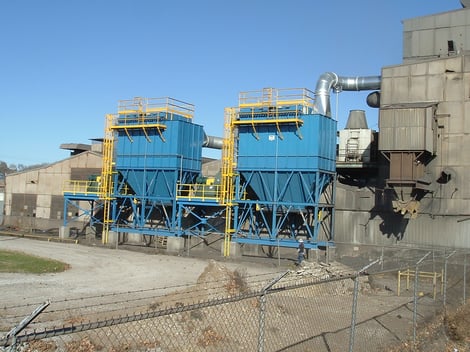When it comes to air quality control, nothing is more tried and tested than the humble baghouse. Used for over a century to capture airborne dust particles in industrial environments, baghouses and dry dust collectors help manufacturers keep their businesses cleaner and ultimately safer for their employees.
With this long history comes innovation. Just as engineers have had the choice between felted filter bags and pleated cartridges, now you can choose between standard low hopper inlet designs and high inlet baghouse models. While these styles vary, choosing between them will come down to:
-
Particle size and density
-
Bridging potential
-
Inlet loading and duct layout capabilities
-
Spacing and device footprint
Conventional Hopper Inlets
Traditionally, baghouses were designed with the dirty air inlet in the hopper below the filter bag. The idea here was that the heavy particulate would drop into the hopper and you’d only collect the finest and lightest dust on the filter media.
While this would seem logical and efficient – which it is for most dry particulate – particularly light dusts and extremely heavy dusts create their own challenges. Light dusts tend to remain airborne within the baghouse and re-entrain themselves on the filter media, while heavy dusts are typically more abrasive, causing premature wear to the inlet, hopper, and filter bags.
These issues forced plant managers and technicians to replace their filter bags every six months or less. Reordering other replacement parts became commonplace as well, putting a financial strain on these businesses. However, it wasn’t until changes were made to the design of inlet itself that industrial facilities were given a viable alternative for handling extremely light/heavy dusts.
Real World Inlet Design Change
A customer with an existing hopper inlet baghouse handling heavy dust complained of premature wear on the equipment and frequent filter bag failure due to the abrasiveness of the dust and air turbulence within the hopper. As the industry leader in dust management with nearly 150 years of experience in air quality control, Sly was ready to help make a change.
To reduce wear on the dust collector and increase collection efficiencies, Sly designed a new high inlet baghouse. This design incorporated a high, side inlet classifying section that isolated the dirty airstream from the bag section and allowed the majority of the heavier dust to drop directly into the receiving hopper. Therefore, only the very fine particulate accumulated on the filter bags reducing the premature failures they had been experiencing and greatly extending the life of the bags.
This baghouse can now be operated for years before having to replace the filter bags instead of months with the previous collector, providing for significantly lower operation and maintenance costs. Further, this integral classifier design minimized incoming airstream turbulence and reduced inlet and housing wear. It also offered much greater flexibility when laying out inlet ductwork for the new collector.

Building off of this initial design, Sly now offers four different styles of high inlet baghouses to handle both sides of the dust weight spectrum. For very light dusts, Style 2 and Style 3 slow the airstream velocity to a point where there is minimal up-draft so that the particulate can drift down into the hopper for discharge. These styles are also extremely effective for the collection of stringy and fibrous products. For heavier dusts, Style 1 and Style 4 incorporate an internal classifier section that directs the dust downward into the hopper, isolating the bags from the incoming airstream entirely.
More information on these high inlet baghouses can be found below:
Style 1: High Inlet Classifier
Sly’s High Inlet Classifier is used primarily for high loadings and heavy dusts. By removing several complete rows of bags, this design introduces high side inlets into bag-free sections that extend the entire width of the dust collector. The inlet sections are separated from the filter housing by using internal partition walls. In this way, the inlet behaves like a classifier, since the contaminated air will expand as it enters the open housing section, reducing its velocity and allowing large particles to be removed from the stream. Further energy is lost as the dust-laden air moves down into the hopper, allowing for further dust removal before entering the filter housing.
Style 2: High Rear Inlet
Typically used for light bulk density dusts, micron-sized particulate, and light loadings, this style removes bags in each row of the collector. No partition wall is used here, and air flows horizontally into the collector’s bag section. Inlets have a target baffle plate installed in front of them at a calculated distance from the back wall of the design to prevent dust-laden air from directly impinging on the filter bags.
Style 3: External High Inlet (Dog House)
A Style 3 inlet is primarily used for light bulk density dusts, small micron sizes, light loadings, and low headroom applications. These types of baghouses are designed around building an inlet plenum, or dog house, onto the side or back wall of the filter housing. The airflow travels horizontally into the bag section, where no internal partition is used. The inlet also has a target plate positioned in front of it to prevent inlet dusty air from directly impinging on the filter bags.
Style 4: High Inlet Classifier on End
Built for high loadings or heavy dusts, Style 4 inlet designs can be used to simplify inlet ducting requirements. Sly creates this style inlet by extending the length of the filter housing and hopper with a bag-free classifying inlet section.
The Sly Difference
No matter what style of baghouse you choose, the dust collection experts at Sly can help you find the right baghouse for your application, as well as customize it to fit your individual needs. Contact us or request a quote today to see the difference that better air quality control can make.
For more information on designing a baghouse, download our handy guide How to Design a Dust Collection System. 
Tags: baghouse, dry dust collector



